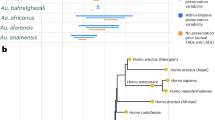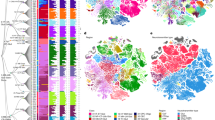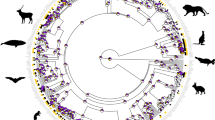Abstract
The mammalian brain comprises a number of functionally distinct systems. It might therefore be expected that natural selection on particular behavioural capacities would have caused size changes selectively, in the systems mediating those capacities1,2,3. It has been claimed, however, that developmental constraints limited such mosaic evolution, causing co-ordinated size change among individual brain components3. Here we analyse comparative data to demonstrate that mosaic change has been an important factor in brain structure evolution. First, the neocortex shows about a fivefold difference in volume between primates and insectivores even after accounting for its scaling relationship with the rest of the brain. Second, brain structures with major anatomical and functional links evolved together independently of evolutionary change in other structures. This is true at the level of both basic brain subdivisions and more fine-grained functional systems. Hence, brain evolution in these groups involved complex relationships among individual brain components.
This is a preview of subscription content, access via your institution
Access options
Subscribe to this journal
Receive 51 print issues and online access
$199.00 per year
only $3.90 per issue
Buy this article
- Purchase on Springer Link
- Instant access to full article PDF
Prices may be subject to local taxes which are calculated during checkout




Similar content being viewed by others
References
Eisenberg, J. The Mammalian Radiations (University of Chicago, Chicago, 1981).
Harvey, P. H. & Krebs, J. R. Comparing brains. Science 249, 140–146 ( 1990).
Finlay, B. L. & Darlington, R. B. Linked regularities in the development and evolution of mammalian brains. Science 268, 1578–1584 (1995).
Innocenti, G. M. & Kaas, J. H. The cortex. Trends Neurosci. 18, 371–372 (1995).
Kaas, J. H. The evolution of isocortex. Brain Behav. Evol. 46, 187–196 (1995).
Dunbar, R. I. M. The social brain hypothesis. Evol. Anth. 6, 178–190 (1998).
Finlay, B. L., Darlington, R. B. & Nicastro, N. Developmental structure in brain evolution. Behav. Brain Sci. (in the press).
Hofman, M. A. On the evolution and geometry of the brain in mammals. Prog. Neurobiol. 32, 137–158 ( 1989).
Ringo, J. L. Brain. Behav. Evol 38, 1–6 (1991).
Butler, A. B. & Hodos, W. in Comparative Vertebrate Neuroanatomy: Evolution and Adaptation. (Wiley–Liss, New York, 1996).
Cousens, G. & Otto, T. Both pre- and post-training excitotoxic lesions of the basolateral amygdala abolish the expression of olfactory and contextual fear conditioning. Behav. Neurosci. 112, 1092-1103 (1998).
Swanson, L. W. & Petrovich, G. D. What is the amygdala? Trends Neurosci. 21, 323– 331 (1998).
Barton, R. A., Purvis, A. & Harvey, P. H. Evolutionary radiation of visual and olfactory brain systems in primates, bats and insectivores. Phil. Trans. Roy. Soc. B 348, 381–392 ( 1995).
Krebs, J. R. Food-storing birds: adaptive specialization in brain and behaviour? Phil. Trans. Roy. Soc. B 329, 153– 60 (1990).
Stephan, H., Frahm, H. D. & Baron, G. New and revised data on volumes of brain structures in insectivores and primates. Folia Primatol. 35, 1–29 (1981).
Stephan, H., Baron, G. & Frahm, H. D. in Comparative Brain Research in Mammals. Vol. 1: Insectivores (Springer, New York, 1991).
Frahm, H. D., Stephan, H. & Stephan, M. Comparison of brain structure volumes in Insectivora and Primates. I. Neocortex. J. Hirnforsch. 23, 375–389 (1982).
Matano, S., Baron, G., Stephan, H. & Frahm, H. D. Volume comparisons in the cerebellar complex of primates. II Cerebellar nuclei. Folia primatol. 44, 182–203 ( 1985).
Matano, S. A volumetric comparison of the vestibular nuclei in primates. Folia primatol. 47, 189–203 (1986).
Felsenstein, J. Phylogenies and the comparative method. Am. Nat. 125 , 1–15 (1985).
Harvey, P. H. & Pagel, M. D. The Comparative Method in Evolutionary Biology (Oxford Univ. Press, Oxford, 1991).
Purvis, A. & Rambaut, A. Comparative analysis by independent contrasts (CAIC): an Apple Macintosh application for analysing comparative data. Comp. Appl. Biosci. 11, 247– 251 (1995).
Purvis, A. A composite estimate of primate phylogeny. Phil. Trans. Roy Soc. B 348, 405–421 ( 1995).
Acknowledgements
We thank R. Grenyer for permission to use an unpublished phylogeny of insectivores.
Author information
Authors and Affiliations
Corresponding author
Rights and permissions
About this article
Cite this article
Barton, R., Harvey, P. Mosaic evolution of brain structure in mammals. Nature 405, 1055–1058 (2000). https://doi.org/10.1038/35016580
Received:
Accepted:
Issue Date:
DOI: https://doi.org/10.1038/35016580
This article is cited by
-
The neck as a keystone structure in avian macroevolution and mosaicism
BMC Biology (2023)
-
Homo sapiens and Neanderthals share high cerebral cortex integration into adulthood
Nature Ecology & Evolution (2023)
-
Evolution of cortical geometry and its link to function, behaviour and ecology
Nature Communications (2023)
-
Phylogenetic comparative analysis of the cerebello-cerebral system in 34 species highlights primate-general expansion of cerebellar crura I-II
Communications Biology (2023)
-
Rapid expansion and visual specialisation of learning and memory centres in the brains of Heliconiini butterflies
Nature Communications (2023)
Comments
By submitting a comment you agree to abide by our Terms and Community Guidelines. If you find something abusive or that does not comply with our terms or guidelines please flag it as inappropriate.



